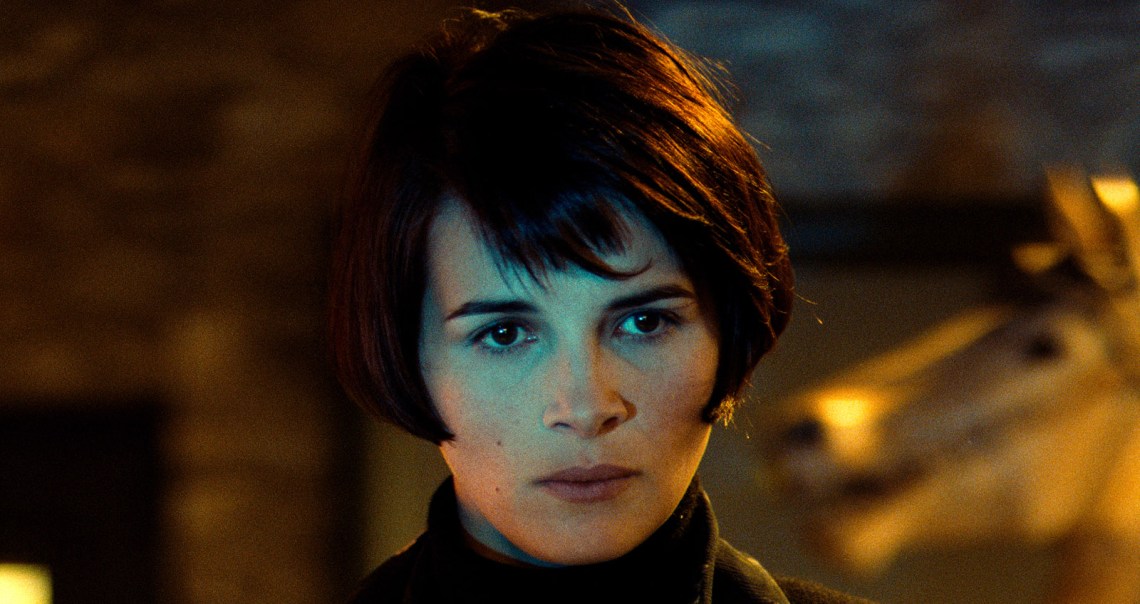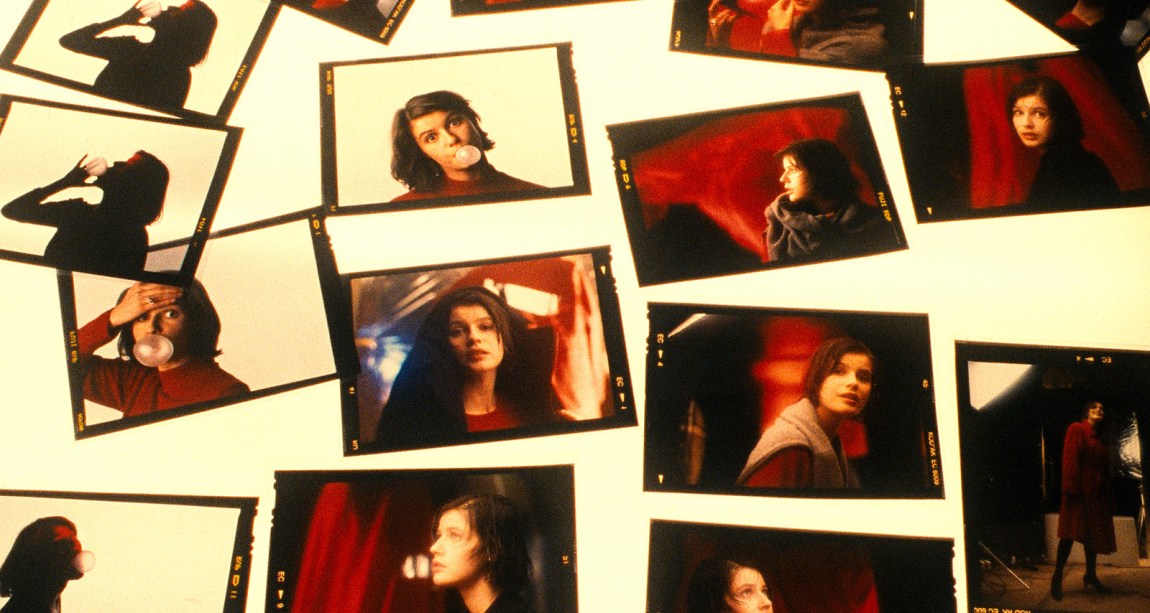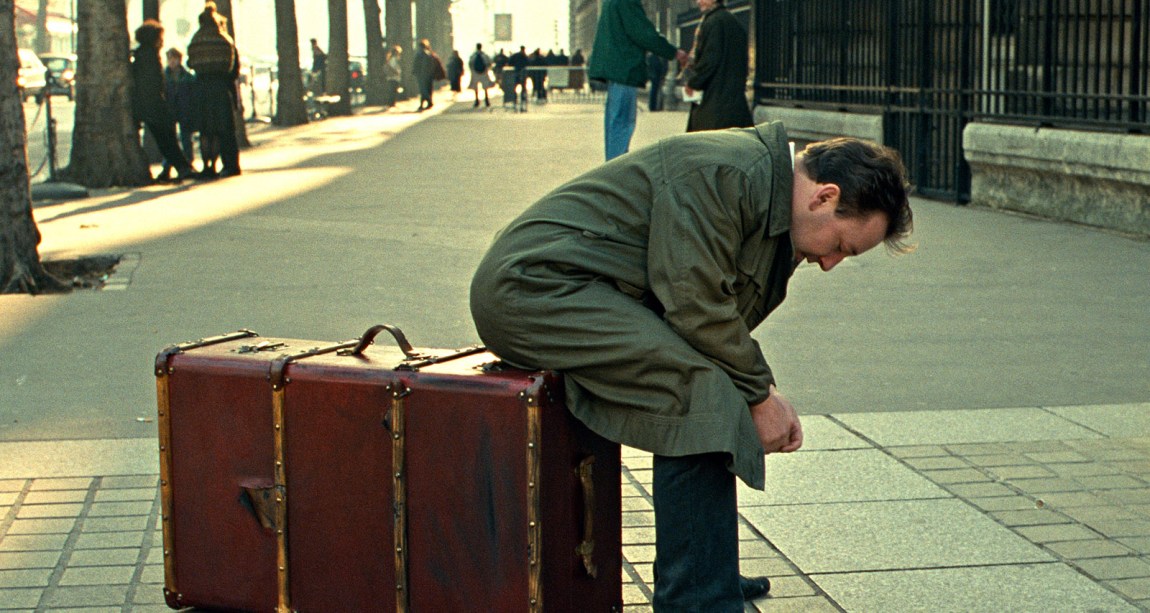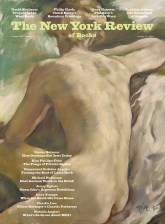Thirty years ago this fall, director Krzysztof Kieślowski’s “Three Colors” trilogy debuted with the release of Blue, followed months later by White and then Red. Kieślowski credited his longtime cowriter, Krzysztof Piesiewicz, with the idea of making a trilogy keyed to the colors of the French flag, with each film exploring one of the ideals of the French Revolution—liberty in Blue, equality in White, fraternity in Red. The title colors are visually foregrounded in ways that are insistent while remaining within the bounds of naturalism. In Blue, a mobile of blue crystals is the only thing Julie (Juliette Binoche) salvages from her family home after her husband and daughter are killed in a car accident. In Red, Valentine (Irène Jacob), a model, poses with a stricken expression on an enormous red billboard. Colored lighting and filters sometimes enhance the effect, as when Dominique (Julie Delpy) is seen in White on her wedding day, emerging from a dim church into a blindingly white world.
This layering of visual and intellectual conceits inspires a number of other formal parallels in the trilogy. For instance, each film begins with a shot tracking an object in motion—a suitcase on an airport conveyor belt, an electronic pulse racing through a telephone wire—and each ends with a close-up on a face that seems to be both weeping and smiling.
All this might sound overly deliberate, and some viewers have found “Three Colors” cold and programmatic. When Red lost the Palme d’Or to Pulp Fiction at Cannes in 1994, it was widely seen as a victory for American pop energy over European artiness. Not everyone was pleased: when the prize was announced, a woman in the audience reportedly shouted, “Kieślowski! Kieślowski! Pulp Fiction is shit!”
There’s no doubt about which director has had the greater influence since then. Tarantino went on to make a series of hit movies, while Red was Kieślowski’s last film before he died in 1996 at the age of fifty-four. Still, when “Three Colors” was released the films were showered with nominations and awards—Oscars, Césars, BAFTAs—and they are still highly admired. In a 2018 BBC poll of critics from forty-three countries, Blue was ranked among the hundred best non-English-language films ever made.
Today the question isn’t so much whether the films retain that high standing, but whether they remain the same films audiences saw three decades ago. The filmmaker himself might doubt it. In Kieślowski on Kieślowski (1993), a book based on interviews conducted while he was writing the screenplays for “Three Colors,” he observed, “It’s a well-known theory that film has twenty-four frames to the second, and that a film is always the same; but that’s not true.” A film is different when viewed on television or in a theater, or even in a huge, full theater versus “a small, smelly cinema in the suburbs.” “It’s a different film,” Kieślowski insists. “It’s not that you experience it differently. It is different.”
Most artworks in any genre become dated over time; if we go back to them, it is for evidence of the way people used to see and feel. It is a rare work that instead develops new dimensions of meaning that could not have been visible to its original audience. This process is especially striking in the case of “Three Colors” because it was made at the very start of a period in European history whose end we are now witnessing: the thirty years’ peace of post–cold war Europe, the era of the “end of history.” From the vantage point of 2023, Kieślowski’s trilogy looks like one of the defining artworks of this period, in which some of its central conflicts are darkly anticipated.
“Three Colors” was a direct product of the fall of the Iron Curtain. Kieślowski was born in German-occupied Warsaw in 1941, and until 1991 all of his films—first documentaries, then features for cinema and television—were made in Poland. In Kieślowski on Kieślowski he talks about the particular constraints and opportunities involved in having the Communist state as his producer. Censorship was a constant reality, but in retrospect Kieślowski remembers it almost as a game he enjoyed playing: “We’d…deliberately film a lot of scenes for the censor to cut out and in this way direct their attention from other scenes.” On the other hand, he says, “I didn’t have to worry about the thing which worries people in the West: the need to muster a budget and to ensure that there is a market for the film.”
The fall of Poland’s Communist government in 1989 made it possible for Kieślowski to work in the West for the first time—and also made it necessary, since state funding for culture dried up. His calling card was Dekalog, a Polish television series broadcast in 1988. Each of its ten hour-long episodes is set in the same Warsaw housing block and deals, loosely, with one of the Ten Commandments: for instance, “Honor thy father and thy mother” inspires a story about a young woman who begins to doubt her true paternity.
Advertisement
Two of the episodes were expanded into stand-alone films, A Short Film About Killing and A Short Film About Love, for distribution abroad, introducing Kieślowski to European and American audiences. They were rapturously received, drawing the attention of producers to an “undiscovered” genius, and in 1991 Kieślowski made his first movie outside Poland: The Double Life of Véronique, a mysterious story about a woman, played by Irène Jacob, who seems to lead two independent existences, one in Paris and one in Warsaw.
It was followed by “Three Colors,” which can be seen as a frank bid by Kieślowski and Piesiewicz to recreate the winning formula of Dekalog. Here again is a series of connected films loosely inspired by a famous list. But while the two projects are separated by only a few years, they belong to different historical epochs and social worlds: the tradition and decay of Eastern Europe have given way to the secularism and prosperity of the European Union. In a sense, Kieślowski and Piesiewicz used “Three Colors” to reflect on the conditions of its own production. The movies were made because the West won the cold war, and they offer a portrait of the victors through the eyes of the vanquished.
White is nominally about equality, but its actual subject is this humiliating inequality between Eastern and Western Europe and the revenge fantasies it breeds. The Polish romance with France is much older than 1989, of course. Since the French Revolution, Poland’s political émigrés had flocked to Paris in the hope of bringing the flame of liberty back home, or at least keeping it alive. The greatest Polish poets of the last two centuries, Adam Mickiewicz and Czesław Miłosz, wrote some of their most important works in Parisian exile.
This history is surely somewhere in the mind of Karol Karol (Zbigniew Zamachowski), the protagonist of White, when he stands in front of Paris’s Palais de Justice and looks up in wonder as a flock of pigeons soars past the inscription on the frieze—“Liberté, Egalité, Fraternité.” The next moment, he’s covered in birdshit. It’s an unsubtle reminder of where a Polish immigrant stands in the French social order, and things only get worse once he enters the courtroom where his French wife, Dominique, is waiting to divorce him. She informs the judge that the marriage hasn’t been consummated. Karol, who has to testify through an interpreter, says he was able to satisfy his wife when they first met, but since their wedding he has been impotent.
It’s the most primitive kind of humiliation: Dominique, as masterful as her name suggests, dismisses Karol, with his foolish double name, like an unsatisfactory servant. The rest of the film is devoted to his elaborate scheme for turning the tables. After an unceremonious return to Poland, where he is promptly beaten up by thieves—“Home at last,” he sighs—Karol embarks on a life of crime, conning farmers out of their land and fencing truckloads of stolen goods. (On the soundtrack album, Zbigniew Preisner’s tango theme for this sequence is titled “Don Karol.”) Having risen to become a petty oligarch, he fakes his own death and lures Dominique to Warsaw by naming her heir to his fortune. Using bribes and forgeries, he then has her arrested for his murder.
Most of White is set in Poland, and while there are moments of lyricism and tenderness, the dominant tone in Kieślowski’s portrait of his country is disgust. In Kieślowski on Kieślowski, he describes it as a place “where everything is wretched, where there’s no truth, only illusion…. I’m very bitter about this life,” he confesses, “about the country which I’ve come from and from which I’ll never escape because it’s impossible.” Karol partakes of the same self-contempt, which makes France, by contrast, seem as regally beautiful as Dominique herself. When we see Karol in his bedroom dutifully listening to French-language tapes, hoping a better accent will help him win his ex-wife back, he stands for every provincial the world over who ever bowed down before the mission civilisatrice.
Yet the film’s greatest cynicism is reserved for France and the West. In the last scene, Karol steals into the prison where Dominique is being held and gazes up at the window of her cell, where she conveys—this time through mime and gesture, leveling the language barrier—that she loves him and wants to get married again. Karol weeps with happiness: he has won Dominique’s love by forcing her to respect him, and what she respects isn’t flowery declarations but money and threats.
Advertisement
The gender politics here are ugly, but as a parable for the relationship between Eastern and Western Europe, White could not be more convincing. For the East, Kieślowski predicts, the advent of capitalism will take the form of organized crime. “These days you can buy anything,” Karol says as he orders up a dead body to bury in his own grave. His career seems to predict developments in countries like Poland and Hungary over the next three decades, as a sense of resentment curdles into belligerent self-assertion.
If White views the West through the eyes of a jealous outsider, Blue asks what it is like to live inside its charmed circle. This time the theme is liberty, in whose name the West fought and won the cold war. But after a lifetime of living in an unfree society, Kieślowski seems to have arrived at a definition of freedom in which political liberty plays no part. “External freedom,” he says in Kieślowski on Kieślowski, “has been achieved—at least in the West, to a much greater extent than the East.” But this is trivial in the face of humanity’s permanent and essential unfreedom:
We’re constantly imprisoned by our passions and feelings…. It makes no difference whether you’ve got a passport which allows you into every country or only into one and you stay there. It’s a saying as old as the world—freedom lies within. It’s true.
In Blue, however, Kieślowski goes even further, suggesting that inner freedom, too, can be a curse. In the film’s first moments, Julie is involved in a car accident that kills her husband, a famous composer, and their young daughter. When she awakens in the hospital and learns what happened, her first instinct is to commit suicide, but when she breaks into a nurse’s medicine cabinet and fills her mouth with pills, she is unable to swallow them. Condemned to life, she resolves to cut out all memories of her past and live entirely in the moment, putting her family home up for sale and disappearing into an anonymous existence in Paris.
What follows is a kind of thought experiment. Julie has every kind of freedom prized in the modern West. Not only can she live anywhere and do anything she pleases, but she is free from family obligations and the weight of the past. She has nothing to consider but her own desires, which are easily satisfied: smoking, swimming, eating ice cream in a café.
Kieślowski claimed to avoid politics entirely in his later work, but Blue is very conscious that the goal of the European Union—founded in November 1993, while the movie was in theaters—was to extend these same blessings to all its members. (Poland joined the EU in 2004.) In the film we learn that Julie’s husband had been commissioned to write a piece of music for the inauguration of the EU, to be played simultaneously by orchestras in the capital of each member nation. It is fleetingly suggested that Julie, also a composer, may have contributed to writing the music that made her husband famous, and despite her renunciations, she is clearly tempted by the idea of finishing the piece herself.
But she soon discovers that total freedom is even more intolerable than the absence of freedom. Without taking any particular initiative, Julie falls into a new set of obligations and relationships—with a downstairs neighbor, a sex worker she defends against eviction; with her husband’s colleague, who reveals his love for her. Even a mouse that gives birth in her apartment provokes a powerful response. Ferrying its pink babies in its mouth, the mouse is a grotesque reminder that the need to care and be cared for is inseparable from every form of life. Despite herself, Julie learns that, in the words of the poet Richard Wilbur, “love calls us to the things of this world.”
Kieślowski sets the seal on her resurrection by having her return to her husband’s unfinished score, which turns out to be a choral setting of Saint Paul’s words about love in 1 Corinthians 13: “If I speak in the tongues of men and of angels, but have not love, I am a noisy gong or a clanging cymbal.” Near the end of the film Christian imagery proliferates, and in the last shot of Julie weeping she seems to have become a mater dolorosa, finally able to mourn the death of her child. There is no mistaking Kieślowski’s belief that the future of Europe lay not in the secular liberalism of the EU but in a return to Christianity.
Nostalgia for religion isn’t the same as actual belief, however, and Red, the last film in the trilogy, asks what kind of faith is still plausible at the end of the twentieth century. Is it possible to believe that our lives are subject to providence, or is the world governed by randomness? Valentine’s story is full of fateful meetings and near misses that send her life, and the lives that intersect with hers, onto different courses. The most momentous coincidence comes at the very end, when she boards a ferry across the English Channel that sinks in an unexpected storm. Some fifteen hundred people are killed and just seven survive—including Valentine and the main characters from Blue and White, who have all ended up on the same doomed ship.
Exactly how is never explained, and in a sense we already know the explanation. All these people are fictional characters being maneuvered by their creator, the filmmaker, for dramatic effect. Eerily, Valentine seems to intuit as much. “It feels like something important is happening around me, and it scares me,” she says. If we often have similar intuitions in real life, does that mean that we, too, are part of a story? And who could be telling that story, if not God or something like him?
“Three Colors” builds to this delicate, tentative insight without committing to any religious dogma. Kieślowski didn’t live to witness the ascent of Poland’s Law and Justice Party, whose strident Christian conservatism would surely have repelled him. (Piesiewicz, who was a human rights lawyer as well as a screenwriter, went on to serve in the Polish Senate as a member of the Civic Platform party, the centrist, pro-European rival of Law and Justice.)
Still, Kieślowski’s understanding of the inadequacies of secular liberalism seems prophetic today, when nationalists and populists have gained power across Europe by promising an antidote to neoliberal rootlessness. In addition to all its formal beauties, “Three Colors” offers a beautiful reminder that artists often intuit more about the direction of history than the statesmen and experts who claim to be steering it.






